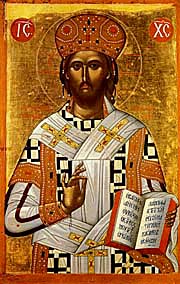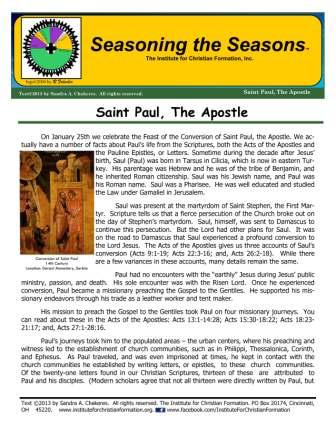The Institute for Christian Formation

Saint Paul
Feast Days: January 25 & June 29

Follow us on Facebook to keep up to date with our news and newest resources!

On January 25th we celebrate the Feast of the Conversion of Saint Paul, the Apostle. We actually know a number of facts about Paul’s life from the Scriptures, both the Acts of the Apostles and the Pauline Epistles, or Letters. Sometime during the decade after Jesus’ birth, Saul (Paul) was born in Tarsus in Cilicia, which is now in eastern Turkey. His parentage was Hebrew and he was of the tribe of Benjamin, and he inherited Roman citizenship. Saul was his Jewish name, and Paul was his Roman name. Saul was a Pharisee. He was well educated and studied the Law under Gamaliel in Jerusalem.
Saul was present at the martyrdom of Saint Stephen, the First Martyr. Scripture tells us that a fierce persecution of the Church broke out on the day of Stephen’s martyrdom. Saul, himself, was sent to Damascus to continue this persecution. But the Lord had other plans for Saul. It was on the road to Damascus that Saul experienced a profound conversion to the Lord Jesus. The Acts of the Apostles gives us three accounts of Saul’s conversion (Acts 9:1-19; Acts 22:3-16; and, Acts 26:2-18). While there are a few variances in these accounts, many details remain the same.
Saint Paul
15th Century, Russian
School: Novgorod

Conversion of Saint Paul
14th Century
Decani Monastery, Serbia
Paul had no encounters with the “earthly” Jesus during Jesus’ public ministry, passion, and death. His sole encounter was with the Risen Lord. Once he experienced conversion, Paul became a missionary preaching the Gospel to the Gentiles. He supported his missionary endeavors through his trade as a leather worker and tent maker.
His mission to preach the Gospel to the Gentiles took Paul on four missionary journeys. You can read about these in the Acts of the Apostles: Acts 13:1-14:28; Acts 15:30-18:22; Acts 18:23-21:17; and, Acts 27:1-28:16.
Paul’s journeys took him to the populated areas – the urban centers, where his preaching and witness led to the establishment of church communities, such as in
Philippi, Thessalonica, Corinth, and Ephesus. As Paul traveled, and was even imprisoned at times, he kept in contact with the church communities he established by writing letters, or epistles, to these church communities. Of the twenty-one letters found in our Christian Scriptures, thirteen of these are attributed to Paul and his disciples. (Modern scholars agree that not all thirteen were directly written by Paul, but that those that were not were likely written by his followers.)

Saint Paul’s letters were written sometime between the years 50 and 65. His Letter to the Thessalonians is the earliest writing we have in our Christian Scriptures (even earlier than the Gospels), and the earliest Christian theology we have available to us. Paul had a great sense of the dignity of all Christians and of equality within the Christian community. His coworkers in ministry were the laity – both women and men, married and single. He also had a strong
sense of Christian charity and justice, and the communities he established took up collections for the needy in Jerusalem. The churches he established, however, had their share of problems and divisions, which were the topic of some of his letters to them.
We often talk about the Church being the Body of Christ. It is Saint Paul who gave us this theology of the community as Christ’s body (see 1 Corinthians 12:12-31).
During his ministry, Paul did have encounters with two of the original twelve Apostles, Peter and James. In addition to the January 25 Feast of the Conversion of Saint Paul, the Apostle, we also celebrate the June 29 Solemnity of Saints Peter and Paul, Apostles.
Tradition tells us that Saint Paul was martyred by beheading in Rome around the year 65-67. He was buried a short distance from where he was martyred. His burial place became the site for Christians to worship Christ and to venerate Paul, the Apostle to the Gentiles. In the fourth century, when the Emperor Constantine ended the persecution of Christians and legalized freedom to worship, a basilica was built over Paul’s tomb. Today you can visit the Papal Basilica of St. Paul Outside-the-Walls. Visit the Vatican web site for a link to this basilica. Here you can find links to information about Saint Paul’s life and ministry, and here you can find detailed history about the basilica, itself. In both cases, keep following the links located on the left side of the pages for more information. You can also take a virtual tour of the basilica, including Saint Paul’s tomb, here.
Pope Benedict XVI declared June 2008 – June 2009 a Year of St. Paul in celebration of the 2000th anniversary of Paul’s birth. Throughout the world, numerous resources were made available to assist in the celebration of this year and in learning more about St. Paul, the Apostle to the Gentiles. Below you can view a video clip about the exhibit “St. Paul in the Vatican”, which was open for three months following the conclusion of the Year of Saint Paul.
You can download our Institute for Christian Formation resources on Saint Paul below.
Click on the image above to download our ICF resource on
Saint Paul, The Apostle
Click on the image above to download our ICF resource on Saint Paul, The Apostle for children
Click on the image above to download our ICF
Saint Paul, The Apostle
Scripture Search
Click on the image above to download our ICF Conversion of Saint Paul
Fill-in-the-Blank activity
Here are links to other good resources for Saint Paul:
The Liturgy Office of England and Wales has some excellent Saint Paul resources online, including “Year of St. Paul Leaflets” which may be downloaded from this page. They include all thirteen of the Pauline Letters.
Loyola Press’s Year of Paul resources include an article about Saint Paul’s missionary journeys which include maps for each journey and a three-act play, “Paul, the Apostle” A play in three acts to celebrate the Year of Saint Paul 2008-2009 by Jeanette L. Graham, M.A.
But the greatest resource available about Saint Paul’s life and ministry remains Scripture. Take some time to read and reflect upon the Acts of the Apostles and the thirteen Pauline Letters in our Christian Scriptures. Remember that you can access Scripture online at the web site of the United States Conference of Catholic Bishops
Saint Paul
16th Century
Heritage: Cretan
An apostle is one who is sent. And while not one of the original twelve apostles, Saint Paul certainly deserves the title. Following his conversion he went on many missionary journeys preaching the Good News and establishing churches. Thirteen of the twenty-one epistles or letters in our Christian Scriptures are attributed to Saint Paul or his disciples. In his message for World Mission Sunday in 2008, Pope Benedict XVI reminds us that we, like Paul, have the duty to preach the Gospel:
It is therefore an urgent duty for everyone to proclaim Christ and his saving message. St Paul said, "Woe to me if I do not preach it [the Gospel]!" (1 Cor 9: 16). On the way to Damascus he had experienced and understood that the redemption and the mission are the work of God and his love. Love of Christ led him to travel over the roads of the Roman Empire as a herald, an apostle, a preacher and a teacher of the Gospel of which he declared himself to
be an "ambassador in chains" (Eph 6: 20). Divine charity made him "all things to all, to save at least some" (1 Cor 9: 22). By looking at St Paul's experience, we understand that missionary activity is a response to the love with which God loves us…
May Saint Paul the Apostle intercede for us that we, like him, may trust in new beginnings and heed our baptismal call to receive the Word and proclaim faith to the Glory of God.



